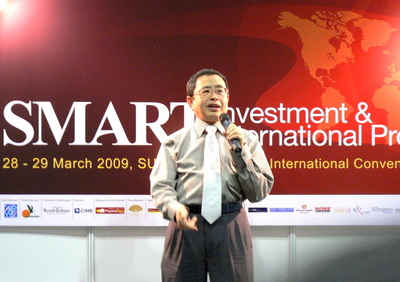Sebastian Chong was a guest speaker at the SMART Investment & International Property Expo held at Suntec City on Mar 28-29. The crowd had filled the seats long before he was due to speak. After his presentation, many people milled around him with lots of questions to ask about stocks. Below is Sebastian’s article on the key things he said at the event.
 Sebastian: Downside of stocks is fairly limited now. Photo by Leong Chan Teik
Sebastian: Downside of stocks is fairly limited now. Photo by Leong Chan Teik
A continuous buy-and-hold strategy adopted since October 2007 would have led to a “Great Depression” of the mental kind. Those who held small cap stocks especially have lost 70% to 90% and those who held blue chips have lost 50% to 70%.
Would it have been helpful if long-term investors had held only the most defensive stocks like SingTel, SingPost, SPH, SMRT and ST Engineering? After taking dividends into account, their shareholders may have lost 40% to 50% since October 2007.
That is still a very significant loss compared with holding cash or the most affordable mass-market condo unit.
Time to start buying again?
The real economies, including those of the US and China, are beginning to show signs of bottoming out in certain economic sectors. Housing starts have improved in February over January in the US.
The Purchasing Managers Index (PMI) has improved in January and February and I do hope that for March it could hit the 50 mark. A PMI of above 50 is a positive indication of an impending growth in manufacturing activity.
Inflation has come down nicely in most economies but there is no threat of significant deflation in the coming months. The world’s two largest of customized chip makers, Taiwan Semiconductors Manufacturing Corporation and United Microelectronics (also Taiwanese) have reported strong rise in orders for their chips.
OPEC has decided not to cut oil production and yet the crude oil price is holding up around USD50 per barrel.
If the fear of job losses is that widespread, we won’t see Sony Brava televisions and Cyber-shots being grabbed as if they were free. Singaporeans still have money to spend. It is just that they are ordering lower priced dishes at restaurants to show that they are financially responsible!
To decide whether to start buying stocks now or whether to wait for the STI to pull back to 1400, I always compare the downside with the upside for the stocks that I like. They include the following stocks:

Many people had questions to ask Sebastian after his presentation. Photo by Leong Chan Teik
§ SGX
§ DBS
§ Ping Ann Insurance
§ Capitaland
§ Keppel Land
§ Cambridge Industrial Trust
§ Capita Retail China Trust
§ Epure
§ CNOOC
§ BHP Billiton
§ Rio Tinto
§ Indo Agri
§ Golden Agri
Yes, if worse-than-expected economic or corporate news hits the US, Europe, Japan, China or Singapore, we may see a 20% to 25% downside (based on intra-day lows) but the potential upside is 100% or more over the next 24 to 36 months.
Even if a piece of economic bad news or a huge corporate fraud implosion in the US or elsewhere causes the STI to pull back to 1400 (intra-day low), chances are that bargain hunters would jump in and the index could strongly rebound to above 1,600 within that same day. In my opinion, there is a 70% probability that we have already seen the bottom (and not merely a bottom) of the Dow and the STI a few weeks ago.
Here’s when to trade equities with a horizon of up to a few weeks or at most a few months:
* When most economic and market indicators suggest strongly that you are in a bear market rally.
* When you are trading fairly volatile stocks in a bull market rally and you believe that a significant correction will set in before the bull cycle resumes
Checklist for picking stocks and derivatives
Stocks
§ Right products and services
§ Right geographic markets and customer segments
§ Above average gross and net profit margins
§ ROE (return on equity) of at least 20% in most years
§ Strong balance sheets
§ Fair dividend policy
§ CAPABLE AND HONEST MANAGEMENT
§ Transparency and good corporate governance
§ Reasonable valuation in terms of PE and P/NTA, risks and returns
§ Importance of diversification of assets
§ Allocate wealth to different asset classes e.g. Property, cash, bonds, mutual funds and ETFs, self-picked equities, commodities, fine wines, fine art, collectibles
§ Reasonable geographical spread for your wealth
§ Ensure that equities are well diversified by industry and geographically
§ Strike a balance between defensive stocks and potential multi-baggers
§ Doing research is important
§ Listening to the market is just as important
§ Reconcile the two whenever possible
§ What if your research and Mr Market are prompting you in opposite directions?
§ Don’t procrastinate in cutting loss
§ Don’t be too quick to take profit in a bull market or too slow in a bear market rally
More on Sebastian Chong here.



